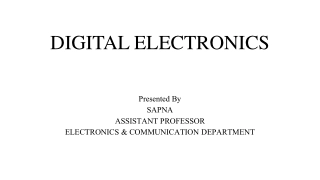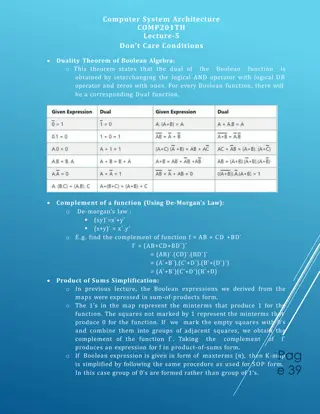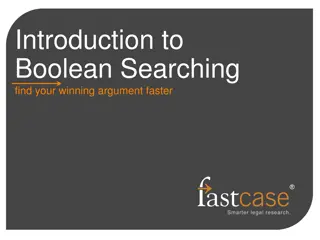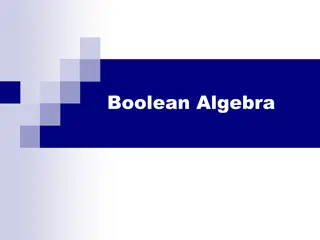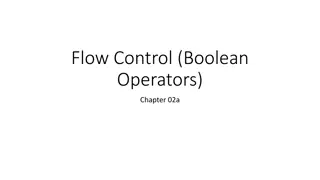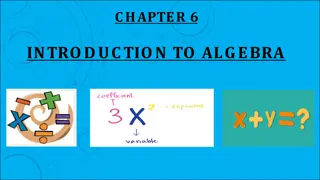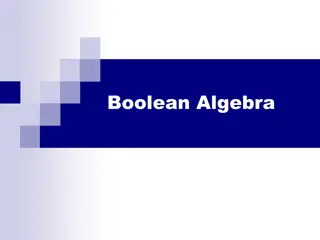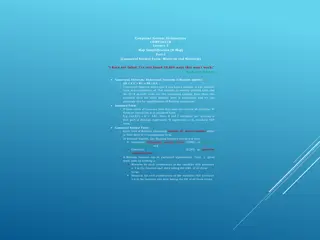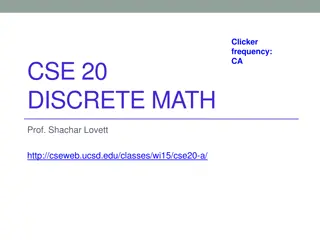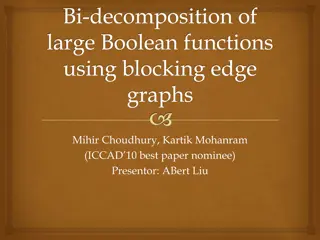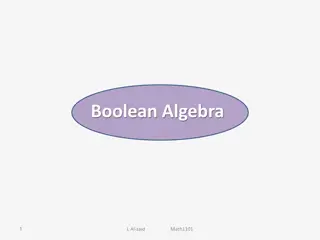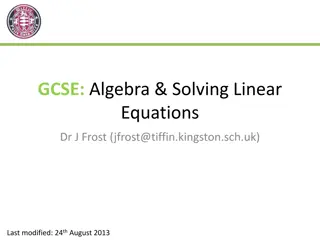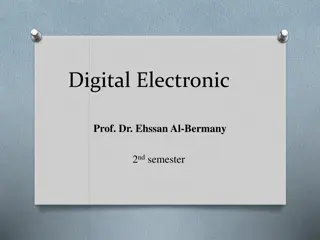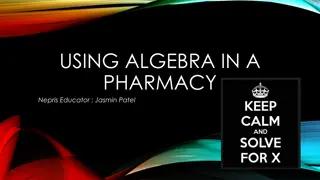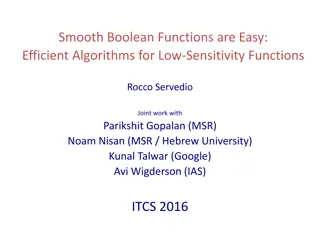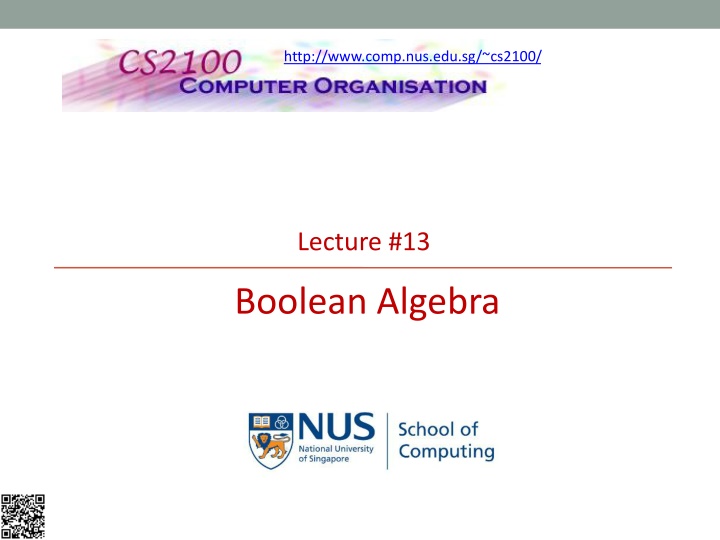
Boolean Algebra for Digital Circuits at NUS
Explore the world of Boolean Algebra in Digital Circuits through Aaron Tan's lecture at NUS covering topics like logic gates, truth tables, and circuit design. Discover the advantages of digital circuits over analog, learn about combinational and sequential circuits, and delve into the fundamentals of Boolean operations. Get ready to enhance your knowledge in this area!
Download Presentation

Please find below an Image/Link to download the presentation.
The content on the website is provided AS IS for your information and personal use only. It may not be sold, licensed, or shared on other websites without obtaining consent from the author. If you encounter any issues during the download, it is possible that the publisher has removed the file from their server.
You are allowed to download the files provided on this website for personal or commercial use, subject to the condition that they are used lawfully. All files are the property of their respective owners.
The content on the website is provided AS IS for your information and personal use only. It may not be sold, licensed, or shared on other websites without obtaining consent from the author.
E N D
Presentation Transcript
http://www.comp.nus.edu.sg/~cs2100/ Lecture #13 Boolean Algebra
Questions? Ask at https://sets.netlify.app/module/676ca3a07d7f5ffc1741dc65 OR Scan and ask your questions here! (May be obscured in some slides)
Aaron Tan, NUS Lecture #13: Boolean Algebra 3 Lecture #13: Boolean Algebra 1. Digital Circuits 2. Boolean Algebra 3. Truth Table 4. Precedence of Operators 5. Laws of Boolean Algebra 6. Duality 7. Theorems 8. Boolean Functions 9. Complement Functions 10. Standard Forms 11. Minterms and Maxterms 12. Canonical Forms: Sum-of-Minterms and Product-of-Maxterms
Aaron Tan, NUS Lecture #13: Boolean Algebra 4 1. Digital Circuits (1/2) Two voltage levels High/true/1/asserted Low/false/0/deasserted High Low Signals in digital circuit Signals in analog circuit Advantages of digital circuits over analog circuits More reliable (simpler circuits, less noise-prone ) Specified accuracy (determinable) Abstraction can be applied using simple mathematical model Boolean Algebra Ease design, analysis and simplification of digital circuit Digital Logic Design
Aaron Tan, NUS Lecture #13: Boolean Algebra 5 1. Digital Circuits (2/2) Combinational: no memory, output depends solely on the input Gates Decoders, multiplexers Adders, multipliers Sequential: with memory, output depends on both input and current state Counters, registers Memories
Aaron Tan, NUS Lecture #13: Boolean Algebra 6 2. Boolean Algebra Truth tables Logic gates Boolean values: True (T or 1) False (F or 0) A B A B 0 0 0 A A B 0 1 0 B Connectives Conjunction (AND) A B; A B Disjunction (OR) A + B; A B Negation (NOT) A'; A ; A; 1 0 0 1 1 1 A B A +B A 0 0 0 A+B B 0 1 1 1 0 1 1 1 1 In CS2100, we use the symbols 1 for true, 0 for false, for AND, + for OR, and ' for negation (you may use the accent bar). Please follow. A A' A A' 0 1 1 0
Aaron Tan, NUS Lecture #13: Boolean Algebra 7 2. Boolean Algebra: AND Do write the AND operator (instead of omitting it) Example: Write a b instead of ab Why? Writing ab could mean that it is a 2-bit value.
Aaron Tan, NUS Lecture #13: Boolean Algebra 8 3. Truth Table Provide a listing of every possible combination of inputs and its corresponding outputs. Inputs are usually listed in binary sequence. x (y + z) x y z y + z 0 0 0 0 0 0 0 1 1 0 0 1 0 1 0 0 1 1 1 0 1 0 0 0 0 Example Truth table with 3 inputs x, y, z and 2 outputs (y + z) and (x (y + z)). 1 0 1 1 1 1 1 0 1 1 1 1 1 1 1
Aaron Tan, NUS Lecture #13: Boolean Algebra 9 3. Proof using Truth Table Prove: x (y + z) = (x y) + (x z) Construct truth table for LHS and RHS x (y + z) x y x z (x y) + (x z) x y z y + z 0 0 0 0 0 0 0 0 0 0 1 1 0 0 0 0 0 1 0 1 0 0 0 0 0 1 1 1 0 0 0 0 1 0 0 0 0 0 0 0 1 0 1 1 0 1 1 1 1 1 0 1 1 0 1 1 1 1 1 1 1 1 1 1 Check that column for LHS = column for RHS DLD page 59 Quick Review Questions Question 3-1.
Aaron Tan, NUS Lecture #13: Boolean Algebra 10 4. Precedence of Operators Precedence from highest to lowest Not (') And ( ) Or (+) Note the difference with CS1231/CS1231S. Here in CS2100, AND has higher precedence than OR. Examples: A B + C = (A B) + C X + Y' = X + (Y') P + Q' R = P + ((Q') R) Hence, A B + C is not ambiguous in CS2100. Use parenthesis to overwrite precedence. Examples: A (B + C) [ Without parenthesis, it means A B+C or (A B)+C ] (P + Q)' R [ Without parenthesis, it means P+Q' R or P+(Q' R) ]
Aaron Tan, NUS Lecture #13: Boolean Algebra 11 5. Laws of Boolean Algebra Identity laws A + 0 = 0 + A = A Inverse/complement laws A + A' = A' + A = 1 Commutative laws A + B = B + A Associative laws * A + (B + C) = (A + B) + C Distributive laws A (B + C) = (A B) + (A C) A 1 = 1 A = A A A' = A' A = 0 A B = B A A (B C) = (A B) C A + (B C) = (A + B) (A + C) * Due to the associative laws, A + B + C is unambiguous. It may be evaluated as A + (B + C) or (A + B) + C. Likewise for A B C.
Aaron Tan, NUS Lecture #13: Boolean Algebra 12 6. Duality If the AND/OR operators and identity elements 0/1 in a Boolean equation are interchanged, it remains valid. Example: The dual equation of a+(b c)=(a+b) (a+c) is a (b+c)=(a b)+(a c). Duality gives free theorems two for the price of one , as a Boolean equation is logically equivalent to its dual. So, you prove one theorem and the other comes for free! Examples: If (x+y+z)' = x' y' z' is valid, then its dual (x y z)' = x'+y'+z' is also valid. If x+1 = 1 is valid, then its dual x 0 = 0 is also valid. Do not confuse duality with negation!
Aaron Tan, NUS Lecture #13: Boolean Algebra 13 7. Theorems Idempotency X + X = X One element / Zero element X + 1 = 1 + X = 1 Involution ( X' )' = X Absorption 1 X + X Y = X Absorption 2 X + X' Y = X + Y DeMorgans (can be generalised to more than 2 variables) (X + Y)' = X' Y' Consensus X Y + X' Z + Y Z = X Y + X' Z X X = X X 0 = 0 X = 0 X (X + Y) = X X (X' + Y) = X Y (X Y)' = X' + Y' (X+Y) (X'+Z) (Y+Z) = (X+Y) (X'+Z)
Aaron Tan, NUS Lecture #13: Boolean Algebra 14 7. Proving a Theorem Theorems can be proved using truth table, or by algebraic manipulation using other theorems/laws. Example: Prove absorption theorem X + X Y = X X + X Y = X 1 + X Y (by identity law) = X (1+Y) (by distributivity) = X 1 (by one element law) = X (by identity law) By the principle of duality, we may also cite (without proof) that X (X+Y) = X.
Aaron Tan, NUS Lecture #13: Boolean Algebra 15 8. Boolean Functions Examples of Boolean functions (logic equations): F1(x,y,z) = x y z' F2(x,y,z) = x + y' z F3(x,y,z) = x' y' z + x' y z + x y' F4(x,y,z) = x y' + x' z x 0 0 0 0 1 1 1 1 1 x 0 0 0 0 1 1 1 y 0 0 1 1 0 0 1 y 0 0 1 1 0 0 1 1 1 z 0 1 0 1 0 1 0 1 1 z 0 1 0 1 0 1 0 F1 0 0 0 0 0 0 1 0 0 F1 0 0 0 0 0 0 1 F2 F2 0 1 0 0 1 1 1 1 F3 F3 0 1 0 1 1 1 0 0 F4 F4 0 1 0 1 1 1 0 0 From the truth table, F3 = F4. Can you prove F3 = F4 by using Boolean Algebra?
Aaron Tan, NUS Lecture #13: Boolean Algebra 16 9. Complement Functions Given a Boolean function F, the complement of F, denoted as F', is obtained by interchanging 1 with 0 in the function s output values. Example: F1 = x y z' x 0 0 0 0 1 1 1 1 1 x 0 0 0 0 1 1 1 y 0 0 1 1 0 0 1 1 1 y 0 0 1 1 0 0 1 z 0 1 0 1 0 1 0 1 1 z 0 1 0 1 0 1 0 F1 0 0 0 0 0 0 1 0 0 F1 0 0 0 0 0 0 1 F1' F1' 1 1 1 1 1 1 0 1 What is F1' ? F1' = (x y z')' = x' + y' + (z')' (DeMorgan s) = x' + y' + z (Involution)
Aaron Tan, NUS Lecture #13: Boolean Algebra 17 10. Standard Forms (1/2) Certain types of Boolean expressions lead to circuits that are desirable from an implementation viewpoint. Two standard forms: Sum-of-Products (SOP) Product-of-Sums (POS) Literals A Boolean variable on its own or in its complemented form Examples: (1) x, (2) x', (3) y, (4) y' Product term A single literal or a logical product (AND) of several literals Examples: (1) x, (2) x y z', (3) A' B, (4) A B, (5) d g' v w
Aaron Tan, NUS Lecture #13: Boolean Algebra 18 10. Standard Forms (2/2) Sum term A single literal or a logical sum (OR) of several literals Examples: (1) x, (2) x+y+z', (3) A'+B, (4) A+B, (5) c+d+h'+j Sum-of-Products (SOP) expression A product term or a logical sum (OR) of several product terms Examples: (1) x, (2) x + y z', (3) x y' + x' y z, (4) A B + A' B', (5) A + B' C + A C' + C D Product-of-Sums (POS) expression A sum term or a logical product (AND) of several sum terms Examples: (1) x, (2) x (y+z'), (3) (x+y') (x'+y+z), (4) (A+B) (A'+B'), (5) (A+B+C) D' (B'+D+E') Every Boolean expression can be expressed in SOP or POS form. DLD page 59 Quick Review Questions Questions 3-2 to 3-5.
Aaron Tan, NUS Lecture #13: Boolean Algebra 19 Quiz Time! SOP expr: A product term or a logical sum (OR) of several product terms. POS expr: A sum term or a logical product (AND) of several sum terms. Put the right ticks in the following table. Expression SOP? POS? (1) X' Y + X Y' + X Y Z (2) (X+Y') (X'+Y) (X'+Z') (3) X' + Y + Z (4) X (W' + Y Z) (5) X Y Z' (6) W X' Y + V (X Z + W')
Aaron Tan, NUS Lecture #13: Boolean Algebra 20 11. Minterms and Maxterms (1/2) A minterm of n variables is a product term that contains n literals from all the variables. Example: On 2 variables x and y, the minterms are: x' y', x' y, x y' and x y A maxterm of n variables is a sum term that contains n literals from all the variables. Example: On 2 variables x and y, the maxterms are: x'+y', x'+y, x+y' and x+y In general, with n variables we have up to 2n minterms and 2n maxterms.
Aaron Tan, NUS Lecture #13: Boolean Algebra 21 11. Minterms and Maxterms (2/2) The minterms and maxterms on 2 variables are denoted by m0 to m3 and M0 to M3 respectively. Minterms Term x' y' x' y x y' x y Maxterms Term x+y x+y' x'+y x'+y' x y Notation m0 m1 m2 m3 Notation M0 M1 M2 M3 0 0 1 1 0 1 0 1 Important fact: Each minterm is the complement of its corresponding maxterm. Likwise, each maxterm is the complement of its corresponding minterm. Example: m2 = x y' m2' = ( x y' )' = x' + ( y' )' = x' + y = M2
Aaron Tan, NUS Lecture #13: Boolean Algebra 22 Quiz Time Again! Ability to convert minterms and maxterms from its Boolean expression to its notation (and vice versa) is important. Test yourself with the following quiz, assuming that you are given a Boolean function on 4 variables A, B, C, D. Maxterm Minterm Boolean expression Maxterm notation Boolean expression Minterm notation (1) A+B+C'+D' M3 (1) m3 A' B' C D A B' C D' A'+B'+C+D' (2) M13 (2) m10 A+B+C+D A B' C D (3) M0 (3) m11 (4) A+B+C'+D (4) A B C D' m14 M2 m9 (5) A'+B+C+D' M9 (5) A B' C' D
Aaron Tan, NUS Lecture #13: Boolean Algebra 23 12. Canonical Forms Canonical/normal form: a unique form of representation. Sum-of-minterms = Canonical sum-of-products Product-of-maxterms = Canonical product-of-sums
Aaron Tan, NUS Lecture #13: Boolean Algebra 24 12.1 Sum-of-Minterms x 0 0 0 0 1 1 1 1 y 0 0 1 1 0 0 1 1 z 0 1 0 1 0 1 0 1 F1 0 0 0 0 0 0 1 0 F2 0 1 0 0 1 1 1 1 F3 0 1 0 1 1 1 0 0 Given a truth table, example: Obtain sum-of-minterms expression by gathering the minterms of the function (where output is 1). F1 = x y z' = m6 F2 = x' y' z + x y' z' + x y' z + x y z' + x y z = m1 + m4 + m5 + m6 + m7 = m(1,4,5,6,7) or m(1,4 7) F3 = x' y' z+ x' y z + x y' z' + x y' z = m1 + m3 + m4 + m5 = m(1,3,4,5) or m(1,3 5)
Aaron Tan, NUS Lecture #13: Boolean Algebra 25 12.2 Product-of-Maxterms x 0 0 0 0 1 1 1 1 y 0 0 1 1 0 0 1 1 z 0 1 0 1 0 1 0 1 F1 0 0 0 0 0 0 1 0 F2 0 1 0 0 1 1 1 1 F3 0 1 0 1 1 1 0 0 Given a truth table, example: Obtain product-of-maxterms expression by gathering the maxterms of the function (where output is 0). F2 = (x+y+z) (x+y'+z) (x+y'+z') = M0 M2 M3 = M(0,2,3) F3 = (x+y+z) (x+y'+z) (x'+y'+z) (x'+y'+z') = M0 M2 M6 M7 = M(0,2,6,7)
Aaron Tan, NUS Lecture #13: Boolean Algebra 26 12.3 Conversion of Standard Forms We can convert between sum-of-minterms and product-of-maxterms easily Example: F2 = m(1,4,5,6,7) = M(0,2,3) Why? See F2' in truth table. x 0 0 0 0 1 1 1 1 y 0 0 1 1 0 0 1 1 z 0 1 0 1 0 1 0 1 F2 0 1 0 0 1 1 1 1 F2' 1 0 1 1 0 0 0 0 F2' = m0 + m2 + m3 Therefore, F2 = (m0 + m2 + m3)' = m0' m2' m3' (by DeMorgan s) = M0 M2 M3 (as mx' = Mx) Read up DLD section 3.4, pg 57 58. Quick Review Questions: pg 60 61, Q3-6 to 3-13.
Aaron Tan, NUS Lecture #13: Boolean Algebra 27 End of File

